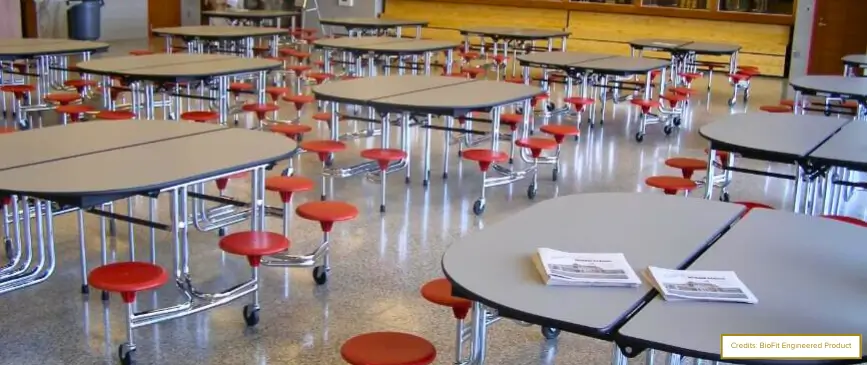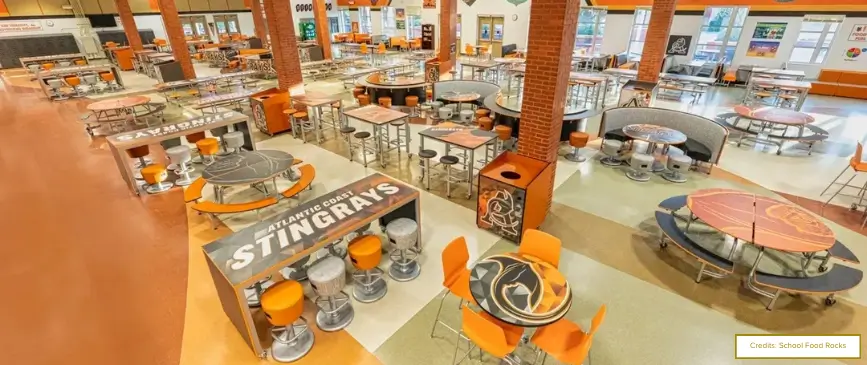Introduction
Students cherish lunch breaks and are even better when their favorite foods are on the menu. Recently, there has been a push to improve the nutritional quality of school meals, leading to significant strides nationwide.
Fast food, a student favorite, has gained significant popularity in many U.S. schools. To balance timelines and provide healthy meals, schools are incorporating fast-food outlets, transforming cafeterias into new “fast food” joints.
But is this a stroke of genius or a recipe for disaster? As cafeteria renovation experts, we have direct experience with the mixed results this trend brings. Here are our quick insights into fast food, its impacts, benefits, and drawbacks on school cafeterias and students.
The Rise of Schools With Fast Food In The Cafeteria
1970s: The Emergence
The 1970s marked a significant shift in school cafeterias with the introduction of fast food in K-12 school cafeterias in the United States. Big fast-food companies saw a golden opportunity and began signing lucrative contracts to promote their brands and offer their quick, heat-and-serve meals to students.
Suddenly, many U.S. schools, including 90% of the National School Lunch Program (NSLP), were serving burgers and fries alongside traditional meals. Despite this fast-food invasion, many schools continued to prepare meals on-site, holding on to more conventional, home-cooked lunches.
1990s: The Fast-Food Boom
Fast forward to the 1990s, and the presence of fast food in schools skyrocketed. McDonald’s led the charge, becoming one of the first major chains to offer its products in school cafeterias. Soon, giants like Pizza Hut, Taco Bell, and Subway jumped on board.
These partnerships meant that students could get branded fast-food meals at school, sometimes even as special treats on certain days. Along with this boom came a surge in vending machines, stocked with sugary drinks and snacks. This made calorie-dense, low-nutrient foods more accessible to students than ever before.
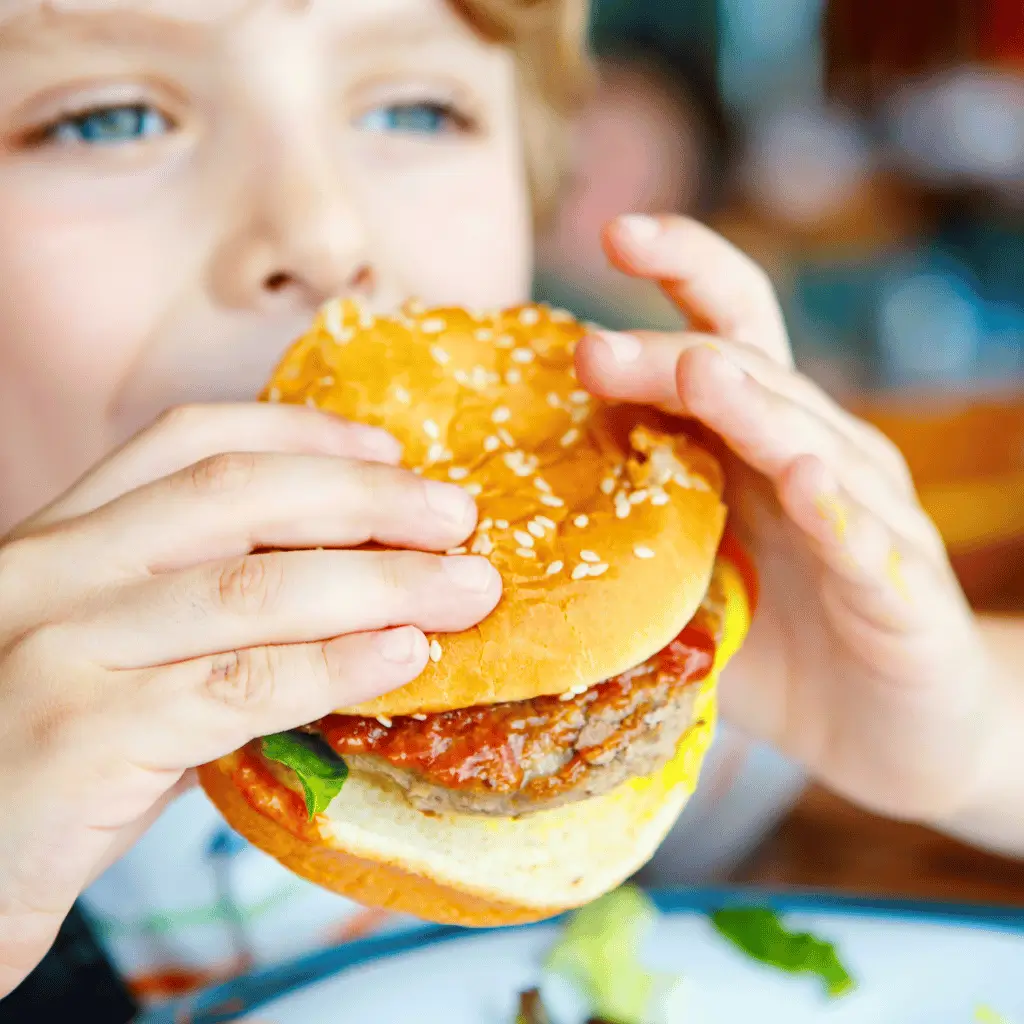
2000s: The Health Wake-Up Call
As the 2000s rolled in, alarm bells started ringing about the health impacts of this fast-food dominance. Concerns about childhood obesity and long-term health risks began to gain serious attention. As a result, the federal government responded by setting nutritional standards for schools in the NSLP, which, sadly, many fast-food items couldn’t meet.
Despite this whole situation, students’ appetite for fast food remained strong.
For example, schools like Allen High School in North Texas feature eight leading food brands serving meals to students. While there has been progress toward healthier options, fast food demands are still on the rise, and the challenge of balancing student preferences while promoting healthy eating in school continues.
The Top 5 Emerging Food Chains at High Schools
With over 100,000 school cafeterias in America serving 30 million students daily, school meals are crucial in shaping students’ connections to food. To modernize their cafeterias and to stay competitive, some schools have teamed with well-known restaurants to upgrade their cafeterias.
The following well-known brands, together with the number of locations they have in school cafeterias, are spearheading the fast-food trend in schools:
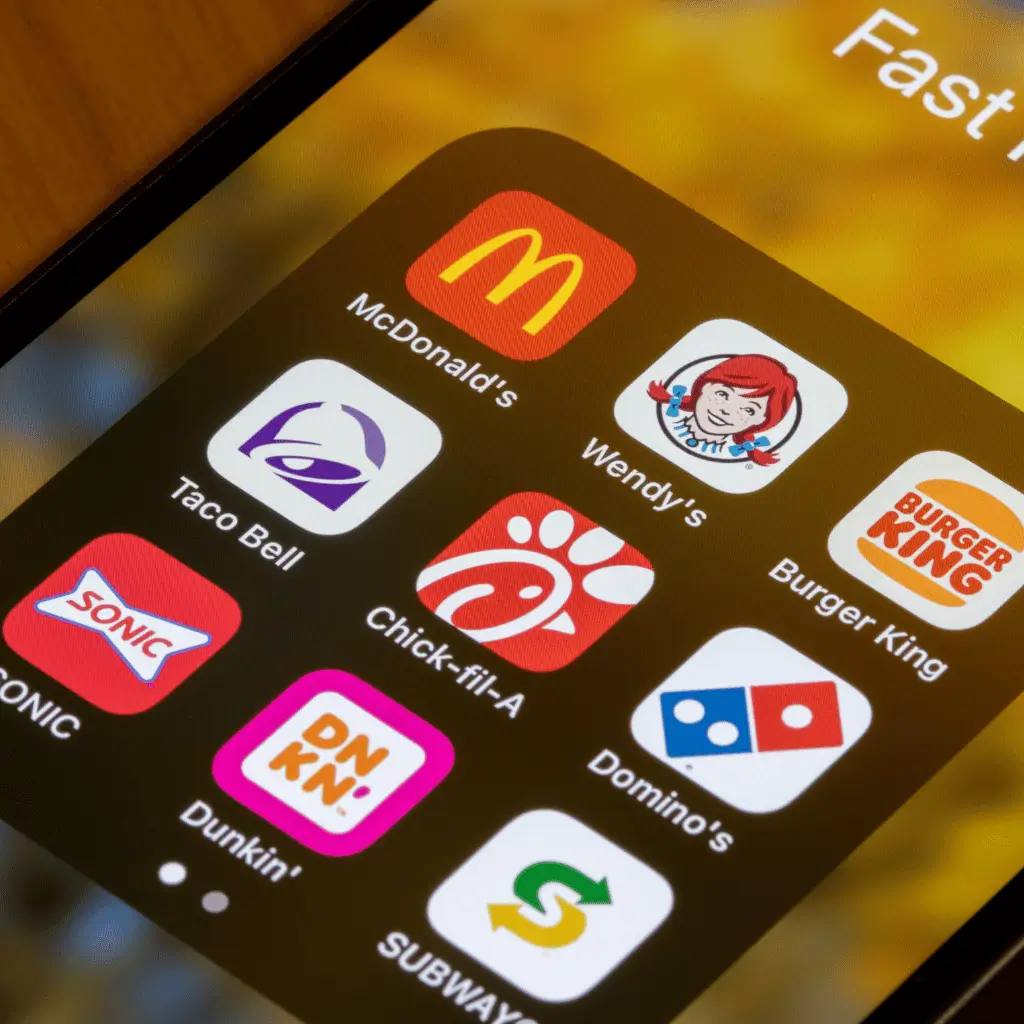
- Subway: 1,200 outlets
- Pizza Hut: 500 outlets
- McDonald’s: 300 outlets
- Taco Bell: 200 outlets
- Chick-fil-A: 150 outlets
Types of Fast Food Offered in School Cafeterias
As experts in cafeteria design, we have encountered numerous schools where fast-food options play a central role in menu planning. These schools recognize the popularity of items such as sandwiches, hamburgers, pitas, french fries, pizza, and tacos among students of all ages.
By including these favorites in their cafeteria options, they ensure that cafeteria meals are convenient and pleasant while also catering to the tastes of their student body. The most popular items among students who attend schools that serve fast food are listed below.
A. Pizza:
- Pizza Hut: Cheese, Pepperoni, Supreme
- Domino’s: Margherita, Pepperoni Feast, Veggie Supreme
- Papa John’s: The Works, Pepperoni, BBQ Chicken & Bacon
B. Hamburgers:
- McDonald’s: Big Mac, Quarter Pounder with Cheese, McDouble
- Burger King: Whopper, Cheeseburger, Bacon King
- Wendy’s: Dave’s Single, Baconator, Jr. Cheeseburger Deluxe
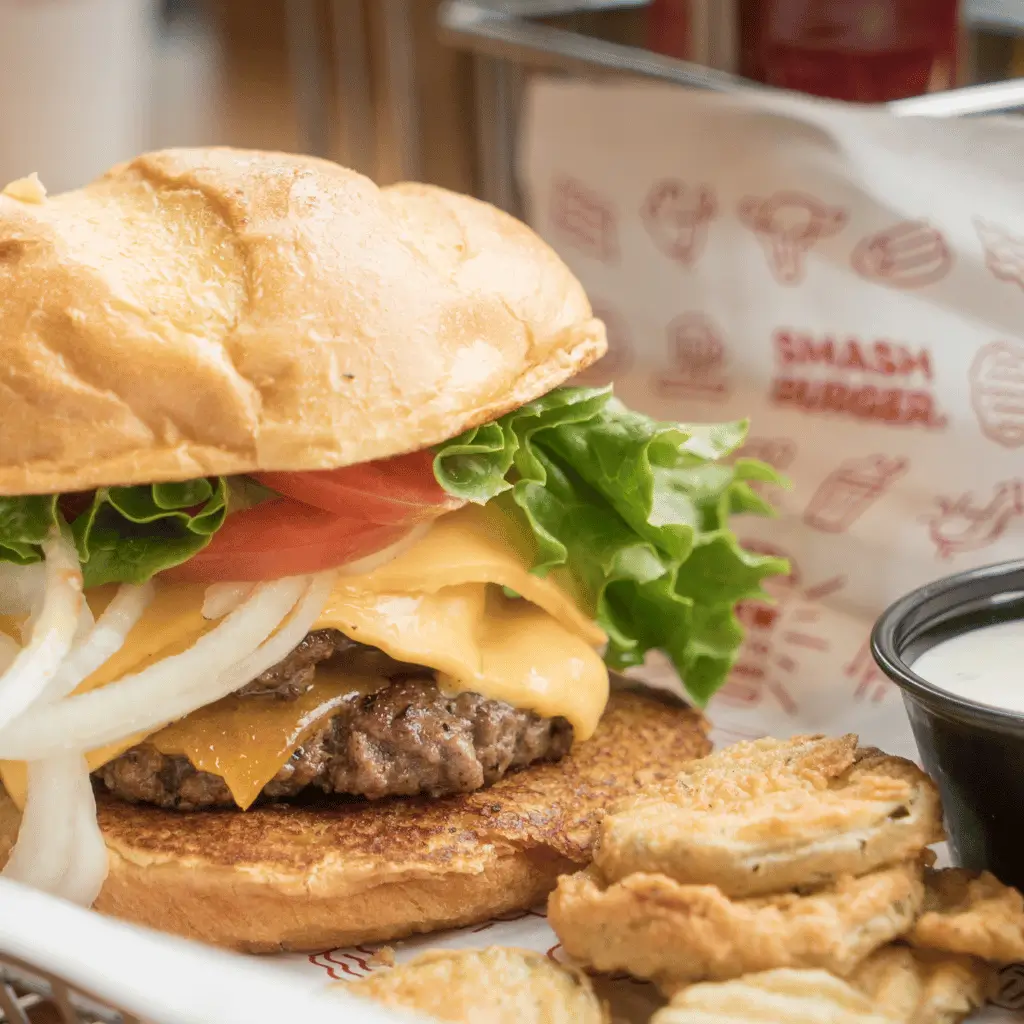
C. Chicken Nuggets:
- Chick-fil-A: Original Nuggets, Grilled Nuggets
- McDonald’s: Chicken McNuggets
- KFC: Popcorn Chicken
D. Sandwiches:
- Subway: Turkey Breast, Italian B.M.T., Veggie Delite
- Jimmy John’s: Turkey Tom, Vito, Veggie
- Panera Bread: Bacon Turkey Bravo, Mediterranean Veggie, Chipotle Chicken Avocado Melt
E. Beverages:
- Soft drinks
- Juices
- Milk
- Water
Suggested Reading → 5 Ways to Deliver on Personalized Food Experience.
The Debate: Pros and Cons of Fast Food in School Cafeterias
As you read through the article, the most common question, “Should fast food be allowed in cafeterias?” might have popped into your mind. Well, that’s fine. Considering whether fast food should grace school cafeterias is a perennial hot potato, raising eyebrows among policymakers, school administrators, stakeholders, and parents alike.
Partnering with big food chains undoubtedly offers students quick and convenient meal options without waiting for traditional cafeteria fare. However, not all that glitter is gold. Research shows that many fast-food products, like burgers, contain up to 50% water and are low in beef, sparking valid concerns about the impact on children’s health.
Suggested Reading → Are School Lunches Healthy?

To give a generic reply to this discussion, here we list some key advantages and disadvantages to weigh when contemplating this contentious issue.
| Pros | Cons |
| It offers a variety of cuisines and cultures. | Could reinforce unhealthy eating patterns. |
| Saves time and effort in preparation. | May not meet nutritional guidelines/policies set by schools. |
| Attracts more students to buy lunch. | Potential increase in obesity rates among students. |
| Reasonably priced options for students. | Concerns about long-term health impacts. |
| Generate additional revenue for schools. | Harmful effects on young, ignorant students (lifestyle diseases). |
| Provides options for pickier eaters. | Hygiene concerns. |
| Allows for customization of meals. | High in calories, oil, carbohydrates, and fat. |
| Offers convenience for students who forget to pack lunch. | Difficult to digest, processed ingredients, high preservatives. |
| Easy and quick preparation for large numbers. | Lack of transparency in ingredient and preparation information. |
| Supplements of nutrition and healthy options are available, including fruits and vegetables. | Potential addiction among teenagers, leading to skipped family meals. |
Fast Food Offerings in School Cafeterias: Facts and Findings
Apart from the above, the availability of fast food in school cafeterias is essential to providing convenience and options for students. However, it must be controlled and supervised to maintain and promote healthy standards. Here are some facts to know.
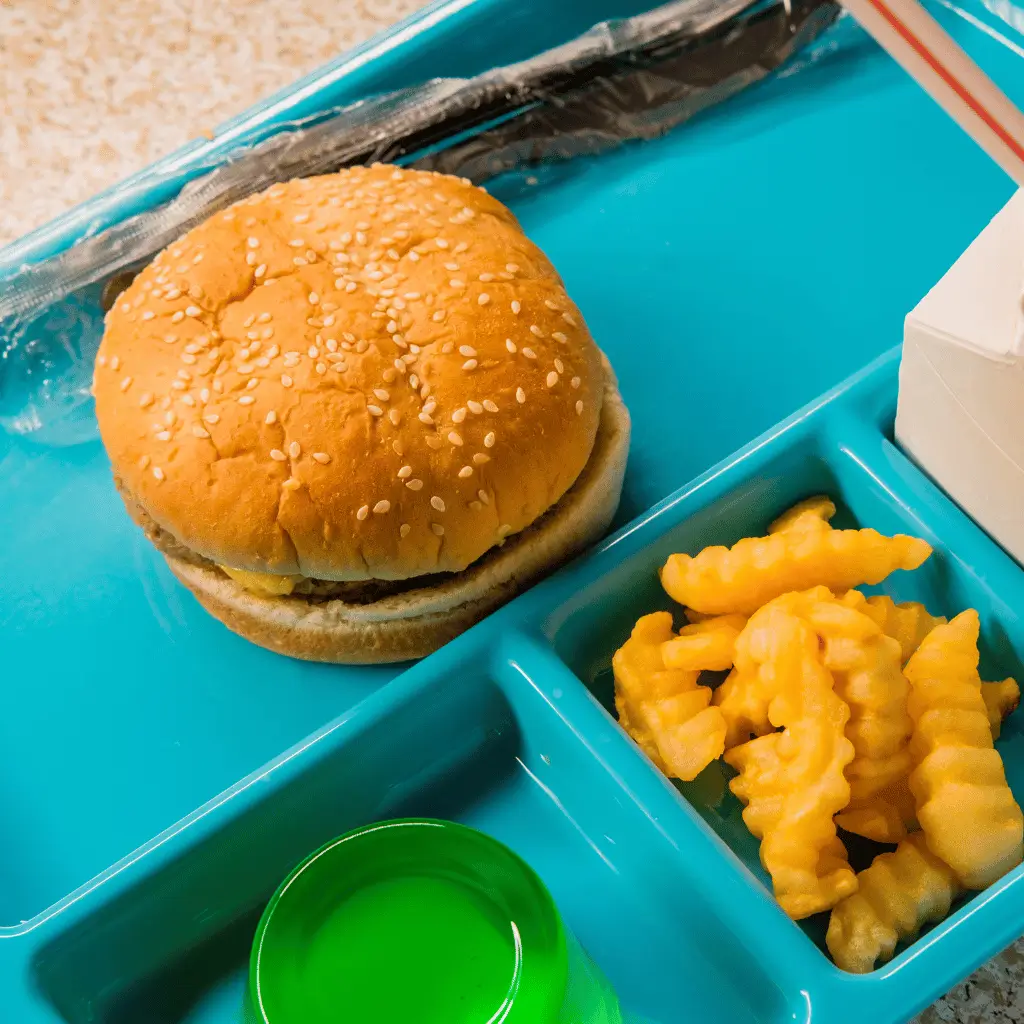
- Many elementary school students (grades K-5) eat snacks daily, with about 36.5% indulging regularly. (USDA)
- For middle schoolers (grades 6-8), the daily snack consumption rises to around 47.3%. (USDA)
- High school students (grades 9-12) top the charts with 58.8% eating snacks daily. (USDA)
- A significant 13% of America’s 86,000 public schools now offer fast food options. (American School Food Service Association)
- Fast food quality is perceived as superior to cafeteria food by many. (Various studies)
- About 33% of American kids and teens enjoy fast food, often during school hours. (Various studies)
- Roughly 40% of high schools provide branded fast-food choices like McDonald’s, Pizza Hut, or Taco Bell. (Various studies)
- Chick-fil-A has gained popularity in school cafeterias for offering perceived healthier fast-food choices. (USA Today)
- Schools are increasingly catering to diverse dietary needs with fast food options such as gluten-free or vegetarian choices. (Various studies)
- About 25% of elementary and 40% of high school students have fast food from school cafeterias at least once a week. (USDA/CDC)
- School partnerships with fast food chains generate around $1.5 billion annually, making up to 20% of their food service budgets. (KappanOnline)
- As of 2024, approximately 30% of U.S. public schools have contracts with fast food chains to serve their products on campus. (USDA)
- A cafeteria questionnaire study poll of around 7000 people revealed that 40% of them prefer fast food in cafeterias or near schools. (Research Journal 2023)
Conclusion
In conclusion, integrating fast food in school cafeterias presents a double-edged sword of benefits and concerns. While it may cater to student preferences and offer financial advantages for schools, it also lifts worries about nutrition and health. Fast-food options can promote unhealthy eating habits and contribute to childhood obesity.
However, they also provide convenience and variety, potentially boosting lunch program participation. Balancing these factors requires thoughtful thinking from educators, parents, and policymakers to ensure student well-being remains a top priority. By making informed choices, schools can navigate this issue while promoting healthy habits among students for their future well-being.
Suggested Reading → Simple Steps for Healthy School Cafeteria.
FAQs
1. Why are fast food options available in school cafeterias?
Fast food options are frequently offered in schools to accommodate students’ dietary needs and offer accessible meal options. This helps ensure children have access to food they enjoy while maintaining a menu that is nutritionally sound and well-balanced.
2. Do students who eat fast food in school cafeterias have healthy options?
Fast food options can be handy, but schools make an effort to provide a balance of healthier options. To support a nutritious diet, they frequently serve a range of nutrient-dense options alongside fast food, such as salads, whole grains, and fresh fruit.
3. How do schools manage the nutritional quality of fast-food offerings?
Schools work closely with nutritionists and dietitians to ensure fast-food offerings meet nutritional standards. They often modify recipes and portion sizes to reduce fat, sodium, and sugar content while providing popular choices that students enjoy.

